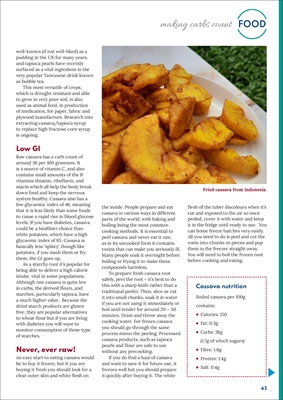
43
FOOD
Cassava nutrition
Boiled cassava per 100g
contains:
Calories: 150
Fat: 0.3g
Carbs: 38g
(1.7g of which sugars)
Fibre: 1.8g
Protein: 1.4g
Salt: 0.4g
well-known (if not well-liked) as a
pudding in the UK for many years,
and tapioca pearls have recently
surfaced as a vital ingredient in the
very popular Taiwanese drink known
as bubble tea.
This most versatile of crops,
which is drought resistant and able
to grow in very poor soil, is also
used as animal feed, in production
of medication, for paper, fabric and
plywood manufacture. Research into
extracting cassava/tapioca syrup
to replace high fructose corn syrup
is ongoing.
Low GI
Raw cassava has a carb count of
around 38 per 100 grammes. It
is a source of vitamin C, and also
contains small amounts of the B
vitamins thiamin, riboflavin, and
niacin which all help the body break
down food and keep the nervous
system healthy. Cassava also has a
low glycaemic index of 46, meaning
that it is less likely than some foods
to cause a rapid rise in blood glucose
levels. If you have diabetes, cassava
could be a healthier choice than
white potatoes, which have a high
glycaemic index of 85. Cassava is
basically less 'spikey', though like
potatoes, if you mash them or fry
them, the GI goes up.
As a starchy root it's popular for
being able to deliver a high calorie
intake, vital in some populations.
Although raw cassava is quite low
in carbs, the derived flours, and
starches, particularly tapioca, have
a much higher value. Because the
dried starch products are gluten
free, they are popular alternatives
to wheat flour but if you are living
with diabetes you will want to
monitor consumption of these type
of starches.
Never, ever raw!
An easy start to eating cassava would
be to buy it frozen, but it you are
buying it fresh you should look for a
clear outer skin and white flesh on
the inside. People prepare and eat
cassava in various ways in different
parts of the world, with baking and
boiling being the most common
cooking methods. It is essential to
peel cassava and never eat it raw,
as in its uncooked form it contains
toxins that can make you seriously ill.
Many people soak it overnight before
boiling or frying it to make these
compounds harmless.
To prepare fresh cassava root
safely, peel the root - it's best to do
this with a sharp knife rather than a
traditional peeler. Then, slice or cut
it into small chunks, soak it in water
if you are not using it immediately or
boil until tender for around 20 - 30
minutes. Drain and throw away the
cooking water. For frozen cassava
you should go through the same
process minus the peeling. Processed
cassava products, such as tapioca
pearls and flour are safe to use
without any precooking.
If you do find a haul of cassava
and want to save it for future use, it
freezes well but you should prepare
it quickly after buying it. The white
flesh of the tuber discolours when it's
cut and exposed to the air so once
peeled, cover it with water and keep
it in the fridge until ready to use. You
can home freeze batches very easily.
All you need to do is peel and cut the
roots into chunks or pieces and pop
them in the freezer straight away.
You will need to boil the frozen root
before cooking and eating.
Fried cassava from Indonesia.
making carbs count